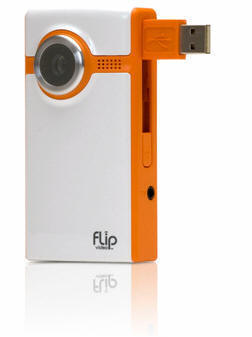|
Video in a Snap
by
Bernard Gorman
Handheld
digital video camcorders in the $300 range are more than adequate for
home movies and those in the $500 range rival those used in TV news
broadcasts of the last decade. As an owner of both early VHS camcorders
and sleeker digital ones, I’ve taken some memorable clips. However, when
I became a proud grandfather two years ago, I realized that I wanted to
have video memories of my granddaughter but I didn’t want to lug cameras
with me to the point of being enslaved by my gear. I wanted to be able
to take video snapshots with video equivalents of the pocket-sized Kodak
Brownie cameras of my childhood.
I’ve
tried and reviewed several pocket camcorders over the years. While they
were innovative, they were either badly-made toys or they were
incredibly expensive. As I could afford those in the “toy” category, I
found that they had very poor resolution; they had very poor battery
life; and they performed badly under ordinary room lighting.
Being
both hopeful and cynical, I stumbled upon a camcorder that’s both
affordable and incredibly useful. In fact, after buying one myself, I’ve
been buying them as gifts. The camera, shown in the picture below, is
the Flip Video Camcorder, Model F160, (www.theflip.com),
made by Pure Digital Technologies. It weighs about the same as a cell
phone. At 4.12” x 2.25” x 1.25”, assuming your trousers aren’t too
tight, it can easily fit in your pocket. The F160 Model costs around
$100 and is available at many department stores, box-box electronics
store, and by web purchase. A deluxe model has a manufacturer’
suggested retail price of around $150.
 Other
than its size, why do I like it? For one, it’s so simple than even
confirmed technophobes (like a certain department chair who shall remain
nameless) can master it in five minutes. It has a small microphone in
the front and a small speaker in the back. A glimpse at the back of the
Flip, shown below, reveals a small monitor and only eight buttons: power
On/Off, play, delete, record, zoom in, zoom out, and forward and
backward. It takes about an hour’s worth of VGA video at 640 by 480
pixel resolution under ordinary lighting using two AA alkaline or NIMH
batteries. The enclosed manual is coupon-sized and about six pages long.
If you want more help, then the Flip Video website and customer services
will answer most of your questions. Other
than its size, why do I like it? For one, it’s so simple than even
confirmed technophobes (like a certain department chair who shall remain
nameless) can master it in five minutes. It has a small microphone in
the front and a small speaker in the back. A glimpse at the back of the
Flip, shown below, reveals a small monitor and only eight buttons: power
On/Off, play, delete, record, zoom in, zoom out, and forward and
backward. It takes about an hour’s worth of VGA video at 640 by 480
pixel resolution under ordinary lighting using two AA alkaline or NIMH
batteries. The enclosed manual is coupon-sized and about six pages long.
If you want more help, then the Flip Video website and customer services
will answer most of your questions.
When
you’re finished shooting, you press a button on the side of the camera
and a USB arm pops out. You then
plug the camera into a USB port on your PC or MAC computer and
it
will install editing,
viewing, and Internet file-sharing software. If you choose not to use
Flip Video’s software, you can use the camera as you would use any other
1GB flash drive. Your files will be in the MP4 format and can be
converted to other formats to make standalone DVD’s. If you wish, the
Flip Video has a composite NTSC (red, white, yellow RCA plugs) video
sockets
and cables
which you can attach to any TV monitor or video recorder.
The
deluxe model has a better monitor; somewhat higher processing speed,
better battery life, and a tripod socket. Friends who have the deluxe
model enjoy these features. In my “wish list” for future Flip Video
models, I’d like to see removable high-capacity SD or HD cards. While
the built-in USB memory is fine for a one-hour video, you have to
transfer the files to a computer and then erase the clips to make room
for new videos. This arrangement is fine for day trips and nearby family
visits but if I were on vacation, I’d like to be able to pop removable
chips in and out without having to go back to the computer. Although I
haven’t played with one yet, the RCA EZ201 camera seems to be similar to
the Flip Video and has removable memory.
In all,
the unit is a delight to use. It’s portable, simple, and gives
high-quality videos. ‘Nuf said! |
